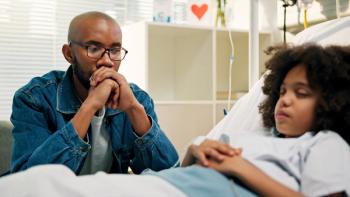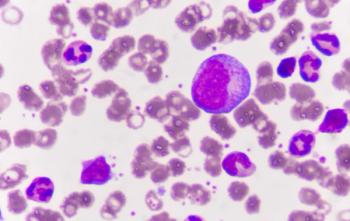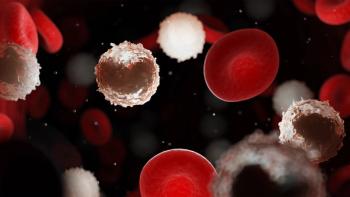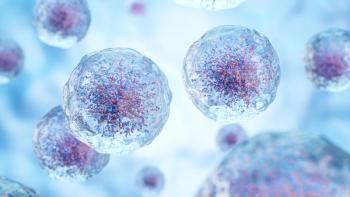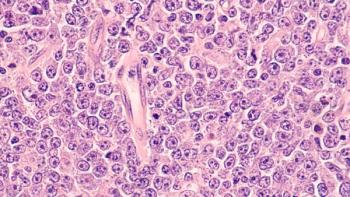
Evolution of DLBCL Treatment Options Render ASCT Unsuitable for Many Patients
In the modern era, the number of patients with diffuse large B-cell lymphoma who will derive benefit from autologous stem cell transplantation is small, according to Jeremy S. Abramson, MD, MMSc.
Today, the majority of patients with diffuse large B-cell lymphoma (DLBCL) will derive most benefit from therapeutic options other than autologous stem cell transplantation (ASCT), according to a presentation from the 2022 Pan Pacific Lymphoma Conference.1
“ASCT is lousy therapy in the modern era,” Jeremy S. Abramson, MD, MMSc, said during the presentation. “There are select patients who are still appropriate for ASCT, but that is a tiny minority in the modern era.”
Abramson is the director of the Lymphoma Program and the Jon and Jo Ann Hagler Chair in Lymphoma at the Massachusetts General Hospital Cancer Center and an associate professor of medicine at Harvard Medical School, both in Boston, Massachusetts.
Salvage treatment with high-dose chemotherapy plus ASCT for patients with DLBCL who responded to their initial treatment often fails most patients, Abramson explained. Approximately 75% of patients who relapse do so within a year of receiving their frontline therapy, he noted, adding that approximately half of patients with relapsed/refractory DLBCL are not eligible for treatment with ASCT because of factors such as age or comorbidities.
Abramson cited data from the phase 3 ORCHARRD trial (NCT01014208), which compared the efficacy of ofatumumab plus cisplatin, cytarabine, and dexamethasone (DHAP) followed by ASCT with that of rituximab (Rituxan) plus DHAP followed by ASCT among patients with relapsed/refractory DLBCL. The 2-year progression-free survival (PFS) rates were 24% and 26%, respectively (HR, 1.12; 95% CI, 0.89-1.42; P = .33). Moreover, the 2-year event-free survival (EFS) rates were 18% and 16%, respectively HR, 1.10; 95% CI, 0.90-1.36; P = .35).2
In another study, the phase 3 NCIC-CTG LY.12 trial (NCT00078949), investigators evaluated gemcitabine, dexamethasone, and cisplatin followed by ASCT vs DHAP in patients with relapsed/refractory aggressive lymphoma. Patients with B-cell lymphoma were also given rituximab. No significant differences were noted in 4-year EFS (HR, 0.99; 95% CI, 0.82-1.21; stratified log-rank P = .95), overall survival (OS; HR, 1.03; 95% CI, 0.83-1.28; P = .78), or PFS (HR, 0.99; 95% CI, 0.82-1.21; P = .95).3
“More contemporary trials [such as] ORCHARRD and the NCIC-CTG LY.12 study [have shown] durable remissions in fewer than a quarter of patients.” Abramson said. “This is not good therapy.”
Abramson said that CAR T-cell therapy is a superior choice for most patients with DLBCL. CAR T-cell agents have proven especially useful in the treatment of patients with primary refractory or early relapsed disease, he said.
In the phase ZUMA-7 trial (NCT03391466), the CAR T-cell agent axicabtagene ciloleucel (axi-cel; Yescarta) was evaluated against the standard of care of chemoimmunotherapy followed by high-dose chemotherapy with ASCT in patients who responded to the chemoimmunotherapy. The trial included patients with relapsed/refractory large B-cell lymphoma who were relapsed or refractory less than 1 year after their first-line treatment. Patients were randomly assigned 1:1 to receive either axi-cel (n = 180) or the standard of care (n = 179).4
At a median follow-up of 24.9 months, the median EFS in the axi-cel arm was 8.3 months (95% CI, 4.5-15.8) compared with 2.0 months (95% CI, 1.6-2.8) in the standard of care arm (HR, 0.40; 95% CI, 0.31-0.51; P < .001). The median PFS was 14.7 months (95% CI, 5.4-not estimable [NE]) vs 3.7 months (95% CI, 2.9-5.3) in the axi-cel and standard-of-care arms, respectively (HR, 0.49; 95% CI, 0.37-0.65). Notably, the median OS in the axi-cel arm was not reached (95% CI, 28.3-NE) vs 35.1 months (95% CI, 18.5-NE) in the standard-of-care arm (HR, 0.73; 95% CI, 0.53-1.01).
In terms of response, axi-cel was also superior to the standard of care. The overall response rate (ORR) was 83% vs 50%, respectively. Patients who received axi-cel also achieved a complete response (CR) rate of 65% compared with 32% among patients treated with the standard of care. Additionally, axi-cel was associated with improved quality of life as evaluated by patient reported outcomes.
The safety findings were mostly similar between the 2 arms; all patients in both arms experienced an adverse effect (AE) of any grade. Grade 3 or higher AEs occurred in 91% of patients and 83% of patients in the investigational and control arms, respectively. However, any grade cytokine release syndrome (CRS) was present in 92% of patients in the axi-cel arm and any grade neurologic AEs were more common in the axi-cel arm compared with the standard-of-care arm (60% vs 20%).
“With CAR T-cell [therapy] we expect some CRS and neurotoxicity; we see a fair amount of that with axi-cel,” Abramson said. “The majority of patients did develop CRS, but it was severe in only 6%. Also, [most] patients developed neurologic toxicity, [but it was] severe in only 20%. And these toxicities are almost entirely reversible.”
Another trial of a CAR T-cell agent, the phase 3 TRANSFORM trial (NCT03575351), examined the efficacy and safety of lisocabtagene maraleucel (liso-cel; Breyanzi) compared with the standard of care among patients with relapsed/refractory LBCL. Patients included in the trial had primary refractory or early relapsed disease.5
At a median follow-up of 6.2 months (range, 4.4-11.5), the median EFS was 10.1 (95% CI, 6.1-NE) compared with 2.3 months (95% CI, 2.2-4.3) in the liso-cel (n = 92) and standard-of-care arms (n = 92), respectively (HR, 0.35; 95% CI, 0.23-0.53; P < .0001). The median PFS was 14.8 months and 5.7 months, respectively (HR, 0.41; 95% CI, 0.25-0.66). The median OS was not reached vs 16.4 months, respectively (HR, 0.51; 95% CI, 0.26-1.00).
Similar to findings from the ZUMA-7 trial, liso-cel also resulted in a higher ORR compared with the standard of care (86% vs 48%). Patients in the liso-cel arm also achieved a CRR of 66% vs 39% in the standard-of-care arm. Over half of the standard-of-care arm (54%) crossed over to be treated with liso-cel and quality of life by patient reported outcomes again favored the CAR T-cell agent.
Treatment emergent AEs (TEAEs) occurred in nearly all patients in both arms (100% vs 99%). Grade 3 or higher TEAEs were slightly more common in the liso-cel arm (92%) compared with the standard-of-care arm (87%). Any grade CRS was present in 49% of patients who received liso-cel.
“As was shown on ZUMA-7 not a single subset [of patients] favored high dose chemotherapy and ASCT over CAR T-cell [therapy] in this trial,” Abramson said. “This was an exceedingly well tolerated and entirely reversible therapy for patients who had a higher likelihood of cure with this treatment compared to standard of care.”
Some Patients Still Benefit from ASCT
Despite the convincing evidence against the use of ASCT, there is still a subset of patients with DLBCL for whom the treatment can be effective, argued Craig S. Sauter, MD, the director of the Blood and Marrow Transplant Programat the Cleveland Clinic in Cleveland, Ohio.
“Value-based care has many facets, including not just end points [such as] EFS, PFS, and OS, but costs strain on limited resources within the space, patient quality of life,” Sauter said. “Financial toxicity is a real issue. Access to resources is a real issue. This will be an ongoing conversation.”
Sauter went on to explain that access to CAR T-cell therapy is limited in the United States and across the world. The cost effectiveness of CAR T-cell agents in the second line is also unclear, Sauter noted. Axi-cel was found to have an $80,000 per quality adjusted life year vs standard of care and CAR T-cell therapy in general was shown to have up to a $2 million per quality adjusted life year compared with standard of care, he said.
Additionally, Sauter noted that ASCT has been shown to provide durable remissions in patients with DLBCL with a PET-positive partial response (PR). According to data from the Center for International Blood and Marrow Transplant Research, the median PFS for patients with DLBCL who received ASCT was comparable both among patients with and without early chemoimmunotherapy failure (P = .22).6
Stauter also pointed out that findings recently published in Blood showed that ASCT may actually be superior to CAR T-cell therapy for patients with DLBCL who are in PR following salvage chemotherapy. The 2-year PFS rates favored ASCT (52%) over CAR T-cell therapy (42%; P = .06). Moreover, the 2-year OS rates were 69% and 47%, respectively (P = .007).7
“There may be a signal of improved durability of ASCT,” Sauter said. “But [these are] very different groups [of patients] and registry-level data that has to be taken with a grain of salt.”
References
- Abramson JS, Sauter CS. Autologous transplantation for DLBCL. Presented at: 2022 Pan Pacific Lymphoma Conference: July 18-22, 2022; Koloa, Hawaii.
- van Imhoff GW, McMillan A, Matasar MJ, et al. Ofatumumab versus rituximab salvage chemoimmunotherapy in relapsed or refractory diffuse large b-cell lymphoma: the ORCHARRD study. J Clin Oncol. 2017;35(5):544-551. doi:10.1200/JCO.2016.69.0198
- Crump M, Kuruvilla J, Couban S, et al. Randomized comparison of gemcitabine, dexamethasone, and cisplatin versus dexamethasone, cytarabine, and cisplatin chemotherapy before autologous stem-cell transplantation for relapsed and refractory aggressive lymphomas: NCIC-CTG LY.12. J Clin Oncol. 2014;32(31):3490-3496. doi:10.1200/JCO.2013.53.9593
- Locke FL, Miklos DB, Jacobson CA, et al; All ZUMA-7 Investigators and Contributing Kite Members. Axicabtagene ciloleucel as second-line therapy for large b-cell lymphoma. N Engl J Med. 2022;386(7):640-654. doi:10.1056/NEJMoa2116133
- Kamdar M, Solomon SR, Arnason J, et al. Lisocabtagene maraleucel versus standard of care with salvage chemotherapy followed by autologous stem cell transplantation as second-line treatment in patients with relapsed or refractory large B-cell lymphoma (TRANSFORM): results from an interim analysis of an open-label, randomised, phase 3 trial [published correction appears in Lancet. 2022;400(10347):160]. Lancet. 2022;399(10343):2294-2308.
- Shah NN, Ahn KW, Litovich C, et al. Is autologous transplant in relapsed DLBCL patients achieving only a PET+ PR appropriate in the CAR T-cell era? Blood. 2021;137(20):2854-2855. doi:10.1182/blood.2021011979
- Shadman M, Pasquini M, Ahn KW, et al. Autologous transplant vs chimeric antigen receptor T-cell therapy for relapsed DLBCL in partial remission. Blood. 2022;139(9):1330-1339. doi:10.1182/blood.2021013289
Newsletter
Knowledge is power. Don’t miss the most recent breakthroughs in cancer care.

